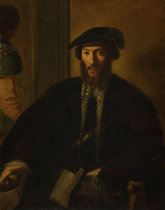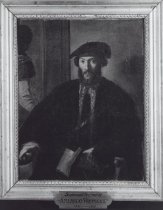Portraits Record
Images


Metadata
Catalog Number |
PA.142 |
Title |
Portrait of a Man, Giovan Battista Castaldi |
Artist |
unknown |
Date |
n.d. |
Description |
Portrait, copy from the North Italian School Seated adult male subject, thigh-length view, turned slightly to his right, eyes gaze forward at viewer. He has brown hair and beard and brown eyes and wears a black hat with a feather and a black coat with white shirt with a black geometric design; he holds an open book in his left hand; his right hand rests on the arm of the chair; the background is brown with objects over his right shoulder |
Object Name |
Painting |
Medium |
Oil Paint |
Material |
Canvas |
Dimensions |
H-46.1 W-36.2 cm |
Credit line |
[Gift of] Dr. Horatio N. Storer |
Provenance |
1878, May 7 - Gift of Dr. Horatio R. Storer Placed on deposit 12 April, 1878. (see letter in painting file) |
Collection |
Painting |
People |
Storer, Horatio Robinson, 1830-1922 unknown Castaldo, Giovan Battista, 1493-1563 |
Notes |
Formerly #60. On the 1859 list there was a painting identified as Americus Vespucius by Tallman (no first name), given by Augustus N. Littlefield. Original is on wood and is in Naples at the Museo e Gallerie Nazionali di Capodimonte. See record #83; supposedly from same person. Copy of the original work by unknown artist. "Eroneously identified with the "portrait of Mr. Giovanni Battista Castaldi", which was preserved in the Guardaroba di Ranuccio I in 1587, this gentleman in black has been frequently, and is still, attributed to Parmigianino, and considered to be a sort of pendant to the Galeazzo Sanvitale. As a matter of fact, in the nineteenth century, as the latter was believed to be a portrait of Cristoforo Columbo, this one was likewise fancyfully named Amerigo Vespucci. The painting, on the contrary, lacks the vibrating mistery of Parmigianino's portraits, and should be rather assigned to another artist active at Parma during the fourth decade of the century. The nonchalance and the lively changing colouring that characterise the servant, turned on his back while going through the door, show the genius of this artist, who could be identified with Anselmi. Exhibited first in the room called Sesta camera detta de'Rittrati of the Palazzo del Giardino, and then in the entrance-hall of the Ducale Galleria, the painting was described in the 1725 printed catalogue. Passed to Naples in 1734, it was moved from Capodimonte to the Real Museo Borbonico, avoiding any further transfer during the events of 1799, or 1806." (world wide web, 1995 by SELFEN S.p.A) |
